In the time of Louis XIV, After the Thirty Years' War from about 1670, France gained supremacy in Europe. It became a leader in science and art, and in terms of custom and fashion, the court in Versailles set the tone for almost every country.
Initially, the women outweighed puffy skirts, loose shoulders, wide sleeves, and fluttering curls. Men wore over an open jerkin a wrinkled skirt and cape, while the trousers took the form of the skirt pants, the so-called Rheingrafenhose. In the following years, the fashion became increasingly pathetic. The main feature of this development was the powerful full-body wig of men. Clothing also became increasingly stiffer. The gentlemen now wore a knee-length, tight-fitting, mostly collarless skirt (Justaucorps) with wide cuffs and patted side pockets; also the bound scarf with short ends, the trousers tied below the knee joint, the threefold, feathered hat, as well as the shoes with tapered heel, buckle and tongue.
The elegant lady wore at this time the Manteau, a garment that billowed on the back and fell down as a train. For example, heavy gold and silver brocades came into fashion as fabrics. Deep cutouts let the waist slide down. To keep the décolleté free, on the contrary, the hairstyle, held up by ribbons, strove upward. This so-called Fontange was the female counterpart to the gentleman's long-necked wig. It was attributed to the Duchess of Fontanges, a mistress of Louis XIV, and held until the beginning of the 18th century.
In the time after Louis XIV, the hairstyles changed; the budget wig replaced the hair bag since about 1730 or since about 1750 the braid. Of the lateral parts of the sponge wig only two curls remained; over the forehead, the hair was stroked back in a beautifully curved line, the back hair stuck in the hair bag.
Among the men was the long skirt with its large cuffs, pockets and flaps, as well as the buckle shoes until the time of Louis XV. the cloak no longer existed in the nobles. The jerkin was open from top to the middle of the chest to reveal the jabot, the lace trim of the shirt on the neck and chest; The pants were tight and was strapped under the knee over the stockings. The hat, which had to be worn under the arm because of the powder, now became a tricorne and received instead of the feathers a trim on the edge. For the women, the hoop skirt came back, along with the lace-upand the horizontally cut out Contouche (robe), elegantly falling on the back. The hairstyle was lower, decorated with feathers or bows; in the back a long ringlet fell down on the shoulder. This costume was preserved as a gala costume until the end of the century, but disappeared since 1760, the hair bag and the braid became shorter.
Women's fashion
Overview
The wide, high-waisted look of the previous period was gradually superseded by a long vertical line, with horizontal emphasis at the shoulder. Full, loose sleeves ended just below the elbow at mid century and became longer and tighter in keeping with the new trend. The body was tightly corseted, with a low, broad neckline and dropped shoulder. In later decades, the overskirt was drawn back and pinned up to display the petticoat, which was heavily decorated.
Romantic negligence
A daring new fashion arose for having one's portrait painted in undress, wearing a loosely fastened gown called a nightgown over a voluminous chemise, with tousled curls. The style is epitomized by the portraits of Peter Lely, which derive from the romanticized style originated by Anthony van Dyck in the 1630s. The clothing in these portraits is not representative of what was worn on the street or at court.
Mantua
The mantua or manteau was a new fashion that arose in the 1680s. Instead of a bodice and skirt cut separately, the mantua hung from the shoulders to the floor (in the manner of dresses of earlier periods) started off as the female version of the men's Banyan, worn for 'undress' wear. Gradually it developed into a draped and pleated dress and eventually evolved into a dress worn looped and draped up over a contrasting petticoat and a stomacher. The mantua-and-stomacher resulted in a high, square neckline in contrast to the broad, off-the-shoulder neckline previously in fashion. The new look was both more modest and covered-up than previous fashions and decidedly fussy, with bows, frills, ribbons, and other trim, but the short string of pearls and pearl earrings or eardrops worn since the 1630s remained popular.
Hunting and riding dress
In a June 1666 diary entry, Samuel Pepys describes the Maids of Honour in their riding habits of mannish coats, doublets, hats, and periwigs, "so that, only for a long petticoat dragging under their men's coats, nobody could take them for women in any point whatever". For riding side-saddle, the costume had a long, trailing petticoat or skirt. This would be looped up or replaced by an ankle-length skirt for shooting or walking.
Hairstyles and headgear
Early in the period, hair was worn in a bun at the back of the head with a cluster of curls framing the face. The curls grew more elaborate through the 1650s, then longer, until curls were hanging gracefully on the shoulder. In the 1680s hair was parted in the center with height over the temples, and by the 1690s hair was unparted, with rows of curls stacked high over the forehead.
Style gallery

1-1667–69.
| 
2-1670
| 
3- 1655
| 
4 – 1659
| 
5 – 1670
|
|---|
1.Susanna Huygens wore a long, tight white satin bodice with paned sleeves lined in pink and a matching petticoat. Her hair is worn in a mass of tight curls, and she wears pearl eardrops and a pearl necklace. 1667–69.
2.Portrait of Barbara Viliers, mistress of King Charles II, painted by John Michael Wright c. 1670 in the romantic style.
3.The Swedish countess Beata Elisabet von Königsmarck wears a white silk gown with a long tight bodice, flat skirt, wide double puffed sleeves, bare shoulders and a deep cleavage. The dress is decorated with blue ribbons and a blue shawl draped around the breasts. She has pearls, and her hair is braided in a knot in the back, but is worn in loose curls over her ears.
4.The Infanta Margarita of Spain is shown, when eight years old, wearing the cartwheel farthingale, 1659.
5.Maria Theresa of Spain wears enormous sleves, bare shoulders, large pearls, a large feather, and has a mass of loose waves.
Men's fashion
Overview
With the end of the Thirty Years' War, the fashions of the 1650s and early 1660s imitated the new peaceful and more relaxed feeling in Europe. The military boots gave way to shoes, and a mania for baggy breeches, short coats, and hundreds of yards of ribbon set the style. The breeches (see Petticoat breeches) became so baggy that Samuel Pepys wrote in his diary: "And among other things, met with Mr. Townsend, who told of his mistake the other day to put both his legs through one of his Knees of his breeches, and so went all day." (April 1661) The wide breeches that made such an error possible were soon being gathered at the knee: Pepys noted, 19 April 1663 "this day put on my close-kneed coloured suit, which, with new stockings of the colour, with belt, and new gilt-handled sword, is very handsome." This era was also one of great variation and transition.
Coat and waistcoat
The unfitted looser fit of the 1640s continued into the 1650s. In the 1650s, sleeves ranged from above to below the elbow. The sleeves could be slashed, unslashed, or dividing into two parts and buttoned together. The length of the coat reached the waist but by the late 1650s and early 1660s, the coat became very short, only reaching the bottom of the rib cage, much like a bolero jacket. During the 1660s, the sleeves varied a lot from elbow length to no sleeves at all. The coat could be worn opened or buttoned in the front. One common factor were many yards of ribbon loops arranged on the shoulders and the lower parts of the sleeves.
Shirt, collar and cravat
The ruffled long-sleeved white shirt remained the only constant throughout the period, although less of it was seen with the advent of the waistcoat.
During the early to mid-1650s, a rather small falling collar was in fashion. This increased in size and encompassed much of the shoulders by 1660. Cravats and jabots around the neck started to be worn during the early 1660s (initially with the falling collar). By the mid-1660s, the collar had disappeared with just the cravat remaining, sometimes tied with a small bow of ribbon. Red was the most common color for the bow, although pink, blue, and other colors were also used. By the 1670s, the bow of ribbons had increased in size and in the 1680s, the bow of ribbons became very large and intricate with many loops of ribbon. By the mid-1690s, the very large bow of ribbons was discarded. Also, a new style of cravat made its appearance in the 1690s, the Steinkerk (named after the Battle of Steenkerque in 1692). Before, the cravat was always worn flowing down the chest; the Steinkerk cravat looped through a buttonhole of the coat.
Breeches and stockings
The previous decade saw Spanish breeches as the most popular. These were stiff breeches which fell above or just below the knee and were rather moderately fitted. By the mid-1650s, in Western Europe, much looser, uncollected breeches, called petticoat breeches became the most popular. As the 1650s progressed, they became larger and looser, very much giving the impression of a lady's petticoat. They were usually decorated with many yards of ribbon around the waist and around the ungathered knee on the outside of the leg. Alongside the petticoat breeches, a collected but still loose fitted breeches called rhinegraves, were also worn. By the early 1660s, their popularity surpassed petticoat breeches. They were usually worn with an overskirt over them. The overskirt was heavily decorated with ribbon on the waist and the bottom of the skirt. Its length was usually just above the knee, but could also extend past the knee so that the rhinegraves underneath could not be seen and only the bottom of the stocking-tops was visible.
Footwear and accessories
Shoes again became the most popular footwear during the 1650s, although boots remained in use for riding and outdoor pursuits. Boothose, originally of linen with lace cuffs and worn over the fine silk stockings to protect them from wear, remained in fashion even when boots lost their popularity. Boothose lasted well in the mid-1660s, attached right under where the rhinegraves were gathered below the knee, or fashionably slouched and unfastened. Shoes from the 1650s through the 1670s tended to be square toed and slightly long in appearance. Usually the shoes were tied with ribbon and decorated with bows. By the 1680s, the shoe became a bit more fitted; the heel increased in height (with red heels being very popular, especially for attendance at Court), and only a small ribbon if any remained.
Hairstyles
Throughout the period, men wore their hair long with curls well past the shoulders. The bangs (fringe) were usually combed forward and allowed to flow over the forehead a bit. Although men had worn wigs for years to cover up thinning hair or baldness, the popularity of the wig or periwig as standard wardrobe is usually credited to King Louis XIV of France. Louis started to go bald at a relatively young age and had to cover up his baldness with wigs. His early wigs very much imitated what were the hairstyles of the day, but they gave a thicker and fuller appearance than natural hair. Due to the success of the wigs, other men started to wear wigs as well. By 1680, a part in the middle of the wig became the norm. The hair on either side of the part continued to grow in the 1680s until by the 1690s two very high pronounced points developed on the forehead. As well, during the 1680s, the wig was divided into three parts: the front including the center part and the long curls which fell well past the shoulders, the back of the head which was combed rather close to the head, and a mass of curls which flowed down the shoulders and back. The curls of the wig throughout the 1660s until 1700 were rather loose. Tighter curls would not make their appearance until after 1700. Every natural color of wig was possible. Louis XIV tended to favor a brown wig. His son, Monseigneur was well known for wearing blond wigs.
Hats and headgear
Hats vary greatly during this period. Hats with very tall crowns, derived from the earlier capotain but with flat crowns, were popular until the end of the 1650s. The brims varied as well. Hats were decorated with feathers. By the 1660s, a very small hat with a very low crown, little brim, and large amount of feathers was popular amongst the French courtiers. Later in the 1660s, very large brims and moderate crowns became popular. Sometimes one side of the brim would be turned up. These continued fashionable well into the 1680s. From the 1680s until 1700, various styles and combinations of upturned brims were in fashion, from one brim upturned to three brims upturned (the tricorne). Even the angle at which the brims were situated on the head varied. Sometimes with a tricorne, the point would meet over the forehead or it would be set at a 45 degree angle from the forehead.
Style gallery
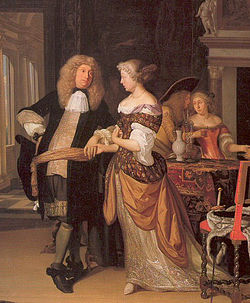
1-1678
| 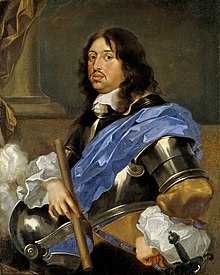
2-1654–1660
| 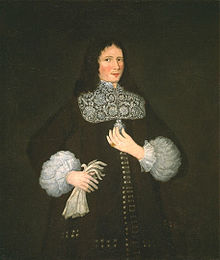
3-1674
| 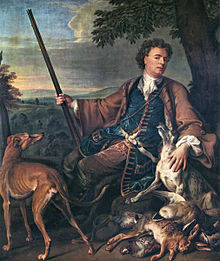
4-1699
| 
5-1690s
|
|---|
1.The elegant gentleman wears a coat, waistcoat, and breeches. The lady's bodice is long-waisted and her narrow mantua is draped and pinned up behind, Dutch, 1678
2.Carl X Gustav (1626–1660), King of Sweden 1654–1660, wears ruffled sleeves, armour, small cravat and flat-lace collar.
3.Puritan influence lingered in New England. This merchant of Boston wears his own long hair, not a wig. The flat lace collar with curved corners that came into fashion in the 1660s is worn over a simple dark coat and waistcoat, 1674.
4.Artist Alexandre-François Desportes in hunting costume. His blue waistcoat has wide buttonholes, and he wears his own hair for outdoor activity. Self-portrait, 1699.
5.The elaborate wig of the 1690s
Children's fashion
Young boys wore skirts with doublets or back-fastening bodices until they were breeched at six to eight. They wore smaller versions of men's hats over coifs or caps. Small children's clothing featured leading strings at the shoulder.

1-1653
| 
2-1658
| 
3-1656
| 
4-1670
| 
5-1682
|
|---|
1.Infante Afonso of Portugal, 1653
2.Child with leading strings, 1658
3.Two English sisters and their brother (right), c. 1656
4.English boys, 1670
5.Swiss girl, 1682
Working class clothing

1-1661
| 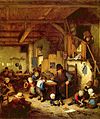
2-1662
| 
3-1662
| 
4-1673
|
|---|
1.Dutch fish seller and housewife, 1661
2.Dutch schoolmaster and children, 1662
3.Checking for lice, 1662
4.Dutch villagers, 1673
Source from Wikipedia
没有评论:
发表评论